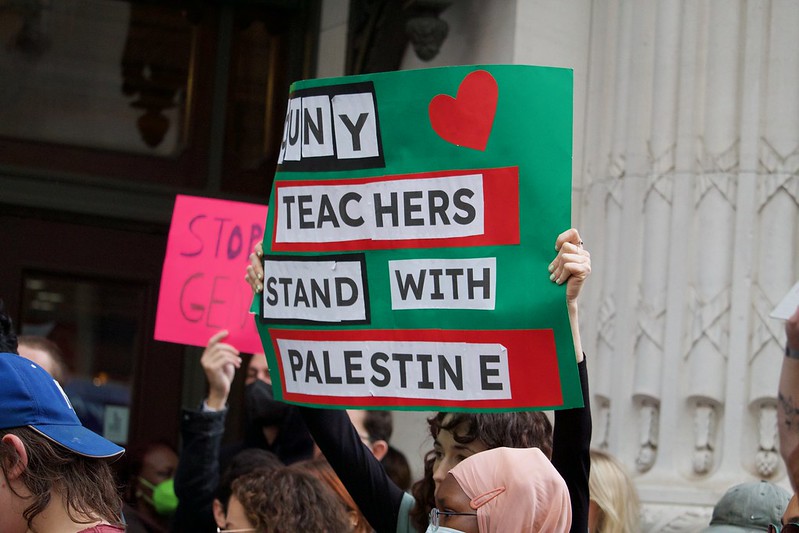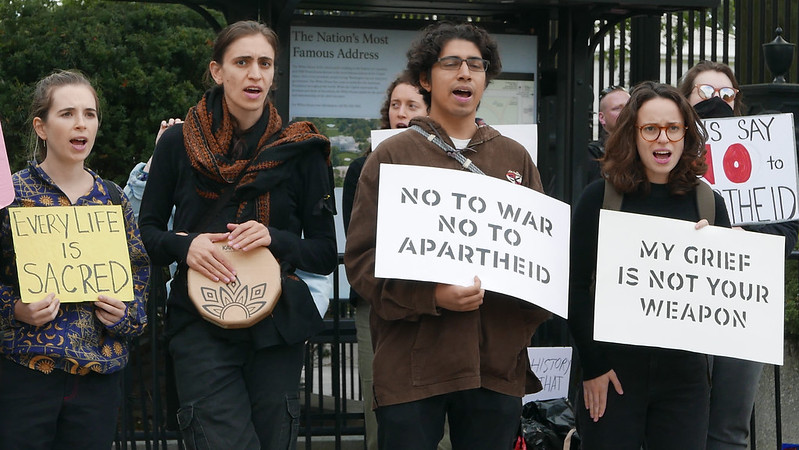
There has been a remarkable wave of protests around the world in response to Israel’s bombardment and blockade of Gaza following the Oct. 7 Hamas attack. How do these protests compare to other national and global waves of mass mobilization? What are their main slogans and objectives? And how should we think about their political significance?
To answer these questions, we invited Jay Ulfelder from the Nonviolent Action Lab in Harvard Kennedy School’s Ash Center for Democratic Governance and Innovation and Jeremy Pressman from the University of Connecticut to share key findings from the Crowd Counting Consortium’s ongoing research project. They’ve been tracking protest activity in the United States since 2017, and make numbers, locations, and slogans available to researchers. The information they collect from a wide range of open sources allows for comparison with previous protests over Gaza, as well as with U.S. protests over other issues.
Marc Lynch: Tell me a bit about this project, and why you’ve been tracking U.S. protests.
Jeremy Pressman: Erica Chenoweth and I started the Crowd Counting Consortium on Jan. 21, 2017 during the first Women’s March. We were curious where people were holding events and how many people showed up. After we tallied that event, we decided to expand the project to make information on any kind of protest, rally, or march going on in the United States publicly available in Google Sheets and, later, at GitHub. We rely on both traditional media and social media sources to gather information on location, crowd size, organizations, etc. We figured other scholars, reporters, and members of the general public would find this information useful, a factual grounding to what they were seeing and hearing. With Jay’s central role, and with many research assistants, we’ve kept the project running for the last six-plus years. We’ve benefited from a range of support, from financial help from the Russell Sage Foundation to The Monkey Cage at the Washington Post as a venue for sharing what we were finding.
Jay Ulfelder: Since early 2022, we’ve also been recording verbatim protester claims from signs, banners, flags, and chants. This gives protesters a chance to tell us in their own words what these events are about, and it helps researchers analyze and compare protest rhetoric in more depth across a wide range of issues. You can find all of our data on our website.
All those previous posts are here on the new site! So what are you seeing in terms of protests related to the Israeli-Palestinian conflict?
Ulfelder: Since Oct. 7, we’ve recorded hundreds of protests across the U.S. in solidarity with both Israel and Palestine, with hundreds of thousands of participants. The first demonstrations occurred on Oct. 7, when we logged four events in support of Palestine. Over the next week, we saw hundreds of vigils and rallies in support of both Israel and Palestine. As I wrote in a recent blog post, since Oct. 7, CCC has logged nearly 460 pro-Palestine rallies, protests, demonstrations, and vigils in more than 190 different cities and towns across 46 U.S. states. More than 130 of those pro-Palestine events occurred over the Oct. 20-22 weekend – and some events drew tens of thousands of participants. Those numbers have only gone up, obviously, on a pretty strong upward trajectory.
Put that in perspective. Is that a lot, compared to other mobilization waves?
Ulfelder: We typically record about 2,000 events per month for the whole country, across all issues, so several hundred in two weeks for one issue area is a lot – especially for an international issue. The number of events is similar in scale to what we saw in May 2022 and then again in June in response to the leaking and then dropping of the Supreme Court decision that overturned Roe v. Wade. In the first few weeks of the George Floyd uprising in 2020, we often logged more than 400 events per day, but that was possibly the largest protest wave in U.S. history, so it’s maybe a less relevant comparison.
And how does this compare to earlier moments of protest during Israeli-Palestinian crises, specifically?
Pressman: U.S. protests during the April-May 2021 crisis were pretty intense as well. I recall hundreds of protests and other events in the U.S. during that time as well. But we should note the nature of that 2021 Israeli-Palestinian crisis was different, by which I mean it was asymmetrical in terms of casualties. Many more Palestinians than Israelis were killed or wounded. Israelis were not feeling the same degree of shock and anger as they do now and, consequently, their supporters in the United States were probably not feeling under attack to the same degree. Also, anecdotally, the pro-Palestinian framing in 2021 drew on much of the same terminology like apartheid, genocide, and occupation as in the current wave.

Ulfelder: Yeah, in May 2021, the CCC recorded about 460 pro-Palestine events for the entire wave – we’ve surpassed that number in just the past couple of weeks, and the rallies and marches and demonstrations just keep coming. We’ve already seen flyers for scores more this week, including a nationwide school walkout on Wednesday, Oct. 25, and many college campuses and larger cities have actions scheduled for upcoming weekdays as well as weekends. The number of participants has also been much larger this time around, with about as many people turning out this past weekend alone as we saw across the entire wave in 2021. Meanwhile, we only logged about 60 pro-Israel events during the 2021 wave, with fewer than 20,000 participants, compared with more than 300 events and 120,000 participants so far in October 2023.
Tell us more about what you’re seeing in this protest wave.
Ulfelder: In terms of dynamics, we saw a wave of events in solidarity with Israel over the first week to 10 days: lots of vigils and sometimes rallies in synagogues, parks, and the like. But those have tapered off since that initial surge.
By contrast, on the pro-Palestine side, we saw a gradual increase over the first week followed by a significant acceleration after Israel said they were shutting off water and electricity to Gaza and gave Palestinians in Gaza an order to evacuate. That specific policy response by the Israeli government and military really seemed to kick U.S. mobilization in support of Palestine into high gear.
In terms of who’s participating, I’d say that the crowds go beyond what we’d ordinarily see at pro-Palestine events, both in their size and their diversity. I’d also say that the crowds at these protests, especially the larger ones, have often been very diverse in terms of participants’ apparent ages, races, and religious backgrounds. You see everyone from toddlers to seniors at many of these events, including some seniors participating in acts of civil disobedience.
At a fair number of events, we’ve seen explicit references to solidarity across national liberation movements from Puerto Rico to the Philippines to Guam. In Los Angeles, San Diego, and Tempe – cities near the U.S. border with Mexico – many Latinos have turned out and made explicit references to Indigenous peoples’ solidarity (e.g., “from Palestine to Mexico these border walls have got to go”). Over the past week, there’s also been a surge in events organized by Jewish groups, usually Jewish Voice for Peace and IfNotNow, focused on calling for an immediate ceasefire in Gaza. These events have included numerous acts of civil disobedience at the U.S. Capitol and various representatives’ district offices, and they’ve led to hundreds of arrests.
Unsurprisingly, though, we also see elected officials at events in support of Israel far more often than we see them at pro-Palestine events. Since Oct. 7, we’ve seen U.S. governors, senators, mayors, and city council members at 74 pro-Israel events. By contrast, we’ve seen elected officials at only eight pro-Palestine events, and none have been governors or U.S. senators.
What are these protesters saying?
Ulfelder: Over the past 10 days, references to genocide have become very common at the pro-Palestine events, and that’s different from previous protest waves. We’re seeing this in signs saying things like “stop the genocide in Gaza” or “there’s no two sides to a genocide” and hearing it in chants like “Biden, Biden you can’t hide! We charge you with genocide!” Only a small share of pro-Palestine events explicitly referenced genocide in the first several days of this wave, but now most of them do.
On the pro-Israel side, we haven’t seen many signs or banners – mostly the Israeli flag and sometimes the American flag or a blended Israeli/American flag as well. When we have seen signs, they’ve often explicitly referenced Hamas (e.g., “Hamas = ISIS” or “save Gaza from Hamas”) or implicitly referenced the Holocaust (e.g., “never again”). And, of course, participants in many of these events have displayed posters with images and bios of Israelis and others taken hostage by Hamas under the title “Kidnapped.”
Pressman: A (very) small share of events take a different tack, expressing sympathy for all civilian casualties – be they Palestinian or Israeli – or calling generally for peace in the Middle East. I’m thinking, for example, of a vigil in Brighton, New York, at the Islamic Center of Rochester or the “Interfaith Peace Vigil for the Middle East” at Mt. Sinai Congregation in Cheyenne, Wyoming. We will keep an eye on whether there is any growth in this category.
Putting on your political science hat, how might we expect these protests to matter politically?
Ulfelder: It’s hard (but not impossible!) to imagine lots of U.S. elected officials changing their minds or votes on policy toward Israel and Palestine, no matter how large this wave gets. That said, I’m really struck by the generational aspect of the mobilization we’re seeing. A lot of young people seem to have very strong beliefs about the importance of Palestinian liberation and the need to restructure the U.S.relationship with Israel, and I suspect those beliefs will eventually push policy in new directions, even if they don’t succeed in doing that now.
Pressman: Each event is an opportunity to spread a specific message on Israel and/or Palestine that gets picked up by social media and, less often, by traditional media. In that sense, protests are one of multiple factors that will help shape the perceptions around what is happening, who is to blame, and what the United States should be doing.
Protesters often try to influence policymakers as well. I’m thinking, for example, of video footage of pro-Palestinian protesters going to congressional offices. But I’d guess that will not be as effective in the short term because U.S. politicians tend to already have strong views on this issue (and usually that view is sympathy and support for Israel, as reflected in Jay’s point about which protests have featured elected officials). In an instrumental sense, crises often lead non-governmental organizations to fundraise – and this could be a moment to increase their membership and resources.
Another way to think about this would be in terms of Biden administration policy. Could protests in the United States influence current U.S. foreign policy? Again, given preexisting policymaker support for Israel, that would be hard to imagine. At a minimum, such influence would require much larger turnout at the protests supporting Palestine and questioning U.S. support for Israel.
At the same time, over the past two decades, more space has opened up to challenge the Washington consensus on support for Israel. Think of statements by Sen. Bernie Sanders (I-Vt.) or Sen. Elizabeth Warren (D-Mass.) in the 2020 primaries – along with recent statements by Rep. Cori Bush (D-Mo.) or Rep. Rashida Tlaib (D-Mich.). So perhaps in the medium term, sustained protest may affect what’s possible.



